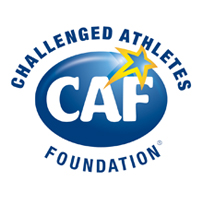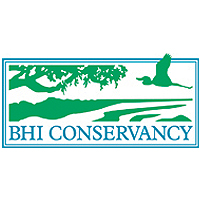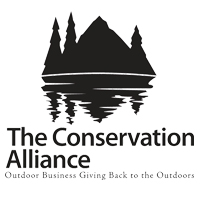support crew
Click here to read this report in English
08:00 Uhr
Abfahrt von unserem Hotel in Stove Pipe Wells. Wir haben den Van gestern abend und seit heute frueh um ca. 6:00 Uhr vorbereitet, gepackt, Eis besorgt, etc. Eine gewisse Nervosität im Team ist zu spüren, aber generell sitzt jeder Handgriff durchdacht und professionell. Robert hat durchgeschlafen und fühlt sich super.
Das Team:
- Robert Wimmer / Ultraläufer
- Sebastian Bär / Head of the BÄR Team
- Tom Aigner / Sportwissenschaftler vom HSZ
- Juergen Ankenbrand / Ultramarathon erfahrener Bekannter von Robert, dt. Auswanderer seit 42 Jahren, lebt in Surf City, CA., Alter: 63 J., kennt Robert vom TransEuropalauf
- Christopher und Audrey Bunn / Fotografen aus USA
- Jürgen Müller / Film und Video, war auch schon beim TransEuropalauf dabei
09:00 Uhr
Ankunft in Badwater, dem niedrigsten Punkt der USA (282 Fuß unter Meeresspiegel). Hier treffen wir auch Marc Cotnoir von der Fa. Rogers / USA, einem Co-Sponsor den wir für dieses Event gewinnen konnten. Fa.Rogers ist unser Lieferant des Poron und Senflex Materials, das wir im Performance MarathonSchuh einsetzen. Er ist selbst Läufer und kann nicht glauben was Robert hier vor hat. Es herrscht bereits grosses Medieninteresse, div. grosse US Sender sind vor Ort. Schon jetzt drückt die Hitze unerbärmlich runter.
10:00 Uhr
Der Startschuss fällt, eine Gruppe von ca. 25 Läufer macht sich auf den Weg 135 Meilen, quer durch das Death Valley. Bereits um 06:00 Uhr und 08:00 Uhr sind Gruppen gestartet mit ähnlich vielen Läufern. Diese sind uns auf der Fahrt zum Start auch schon gegegnet. Insgesamt sind es ca. 80 Läufer.
Nach 10 Meilen
Die Team Betreuung von Robert hat sich nach den ersten 2 bis 3 Stops eingependelt: wir halten ca. jeden 1,5 km und geben Robert ½ Liter Getränk (Elektrolyt, Frubiase, Wasser im Wechsel) und ein Gel mit Kohlehydraten, Banane, Trauben, Melone, Power Riegel, Vitamin Fläschen, etc. immer im Wechsel. Außerdem sprühen wir ihn im Nacken, auf dem Kopf, an den Armen und auf der Brust mit kaltem Wasser jedes Mal ein. Jetzt wollen wir ihn noch mal eincremen mit Sonnencreme, da die Sonne unglaublich intensiv runterknallt und sagen ihm er soll stehen bleiben, worauf er auf seinem typischen Fränkisch antwortet: „Nee, i bleib net stehn!“.
Meile 16,4
Christopher Bergland führt vor Robert Wimmer mit ca. 1 km. Temperatur ca. 52° C. Robert läuft ein gleichmäßiges Tempo.
Meile 17,4
Hier befindet sich die erste Zeitmessstation. Robert spricht jetzt etw. weniger, eine gewisse Anspannung ist spürbar. Nichts negatives, ihm geht es auch nicht schlecht, aber die Hitze steht nun eben immer noch bei 52° C. Pam Reed und Dean Karnazes, beides Favoriten in diesem Rennen, sind momentan nicht in Sicht. Halten sich wahrscheinlich hinten und warten, ob vorn jemand einbricht.
Meile 18,8
Abstand zu Christopher Bergland wird langsam geringer. Wir geben Robert jetzt etw. verdünntes RedBull, dass sich seine Psyche wieder etw. aufhellt.
Meile 19,5
Wir wechseln auf Kommando von Robert seine Einlegesohle von der LAST Einlegesohle in die Performance Einlegesohle. Die LAST ist sprichwörtlich platt, v.a. im Ballenbereich.
Meile 22,0
Robert lacht, läuft wie eine Maschine. Die Performance Einlegesohle ist tiptop, wird ihm auch nicht zu warm an den Fußsohlen. Wir haben jetzt vom sprühen auf einen Eisschwamm gewechselt. Die Praxis hat gezeigt, dass dies besser funktioniert, um die Körpertemperatur unten zu halten, als das einsprühen. Robert wendet sich auch an uns und fragt, ob wir ausreichend trinken, um nicht zu dehydrieren in dieser Teufelshitze. Er ist bester Laune. Es ist 14:00 Uhr und es sind weiterhin 52° C. Eisschwämme nimmt er super gerne, drückt diesen auf Kopf, im Nacken, an den Armen und Oberschenkeln aus. Der jeweilige Betreuer hat hier auch beim versorgen immer einen Eimer mit Eiswasser mit dabei, so dass der Schwamm währenddessen immer wieder vollgesogen werden kann. Mittlerweile hat Robert auch schon einige aus der 08:00 Uhr Startwelle überholt. Jetzt startet Robert ein wenig psychologische Kriegsführung: er ist aufgeschlossen zu Christopher Bergland, hat ihm gezeigt – hey, ich bin da und mir geht es gut und ich lass Dich die Arbeit machen. Wir füttern ihm jetzt auch Babyfood (ähnl. Hipp Baby Gläschen) und lassen ihn ein paar Meter gehen, so dass der Abstand auf Bergland wieder 150 m nach vorn beträgt. Verfassung bei Robert ist super gut! Temperatur weiterhin 52° C.
14:26 Uhr
Die Temperatur ist mittlerweile hoch auf 60° C (!). Das ist Sauna im Freien, es ist unvorstellbar im Moment. Jetzt geben wir Robert jeden km den Eisschwamm und weiterhin 1⁄2 Liter Getränk. Den ersten Marathon hat er in ca. 3 Std. 40 Min. Gelaufen.
Bergland hat sich soeben in seinen Crew Van gesetzt, d.h. Robert führt jetzt das Feld an. Es sieht so aus, dass Christopher Bergland einen Krampf hat und er fällt zurück. Die Crew Vans von Dean Karnazes fahren immer wieder vor zu uns und beobachten, in welcher Verfassung Robert ist. Dean Karnazes macht auch langsam Boden gut. Robert sagt, das ist ideal für ihn. Er hat ihn vorbei gelassen und läuft jetzt hinter ihm her sein eignes Tempo. Es sind weiterhin 60° C.
Karnazes macht jetzt etw. mehr Tempo, liegt ca. 600 Meter vor Robert. Wir machen mittlerweile fast alle 600 – 800 Meter Verpflegungsstops (Robert bleibt während dieser Stops nicht stehen, sondern alles läuft im Lauftempo von Robert ab) und kühlen ihn mit dem Eisschwamm. Die Hitze hämmert unerbärmlich runter. Robert spürt seine Waden etwas, daher geben wir ihm mehr Frubiase und Elektrolyte.
Wir selbst im Team müssen uns mit Sonnencreme mit Schutzfaktor 60 eincremn und tauchen unsere Baseball Caps regelmässig in Eiswasser.
15:15 Uhr
Robert wird von einem Auto angefahren. Ein englischer Tourist hat ihn übersehen und bleibt bei vollem Tempo mit seinem Rückspiegel an Roberts Hüfte hängen. Robert schreit kurz auf, der Autofahrer fährt weiter. Wir fahren an die Seite, ich renne zu Robert, Juergen macht Eis bereit und Tom… Tom vergisst die Automatik des Vans von „D“ auf „P“ zu stellen, vor lauter Aufregung. Unser Van macht sich selbstständig und fährt quer über die Strasse auf die andere Seite und bleibt im Seitengraben hängen. Robert gibt mir die Info, dass es geht und läuft weiter. Zum Glück ist bei all dem nichts passiert. 10cm mehr und das Rennen wäre vorbei gewesen. Zufällig war einer der Race Officials in der Nähe und jagt hinter dem britischen Touristen her. Das Rennen läuft weiter.
15:54 Uhr
Nachdem der Schrecken verdaut ist, läuft jetzt alles wieder in seiner gewohnten Routine. Dean Karnazes liegt etwa 600 Meter vor Robert, muß aber auch immer wieder gehen. Es weht mittlerweile auch ein Wind, der leider nicht kühlt, sonder sich eher anfühlt als würde jemand einem einen großen Fön auf höchster Stufe vor den Körper halten. Wir versuchen kontinuierlich Robert ausreichend zu versorgen, dass sein Körper mit hält und er einigermaßen hydriert bleibt. Nur noch ein paar Meilen bis Stove Pipe Wells. Rechts von uns liegen die riesigen Sanddünen. Temperatur ist wieder runter auf 52° C. Ab Stove Pipe Wells wird es langsam bergauf gehen, dann wird es auch etwas kühler werden.
Mittlerweile geben wir Robert auch Tomatensaft, dass er mal einen anderen Geschmack in den Mund und v.a. dass sein Körper wieder Salze nachgeliefert bekommt. An den Sanddünen vorbei, noch ca. 2 bis 3 km bis Stove Pipe Wells. Dort ist auch ein Pool an dem Motel, in dem wir die letzten zwei Tage gewohnt haben.
Roberts Psyche geht gerade wieder etwas runter, die Versorgung läuft routiniert, wir versuchen Energie in ihn reinzuladen, wie es nur geht.
16:25 Uhr
Dean Karnazes ist jetzt erst mal weiter vor, wir sind kurz vor Stove Pipe Wells.
Meile 42
Robert hat sich im Pool entspannt abgekühlt und dann ein frisches Trikot etc. angezogen. Das hat ihm gut getan. Ich hab 6 x versucht Dr. Thomas Prochnow – seinen Coach – zu erreichen, vom payphone in Stove Pipe, leider hat es nicht geklappt. Er hätte Robert noch mal psychologisch aufbauen und motivieren können. Audrey hat uns währendessen nochmals 10 Tüten Eis besorgt und Jürgen mehr Wasser. Nach der Pause habe ich Robert erzählt, dass ich Thomas Prochnow erreicht habe und dass er gesagt hat dass Robert alles richtig macht, dass Thomas voll hinter ihm steht und ihm die Daumen drückt für den weiteren Verlauf des Rennens. Robert hat sich super gefreut. Dean Karnazes ist ohne Pause durchgelaufen. Uns selbst läuft der Schweiß runter wie nichts, obwohl wir nur im Auto sitzen mit offenen Fenstern, wo auch noch der Wind durchzieht.
17:12 Uhr
Jetzt geht es langsam bergauf in die Berge. Temperatur 52° C. Auf einmal begegnen wir Dean. Er musste stoppen und Schuhe wechseln. Psychologisch das Beste was Robert passieren konnte: Robert war entspannt im Pool, hat etwas gegessen, während Dean ohne Pause weitergelaufen ist. Dean hat nagelneue Turnschuhe angezogen. Robert ist jetzt vorbei an ihm. Es geht stetig bergauf, aber wir kriegen ihn trotzdem immer wieder zum lachen. Wir versorgen ihn verstärkt mit Vitaminen, Elektrolyten, Kohlehydrate-Gels, etc. und überraschen ihn immer auch mal wieder mit Melone etc. Jetzt liegt er in Führung mit ca. 400m vor Dean.
Tom und ich wechseln uns mit Robert versorgen bereits den ganzen Tag ab, bis einer aufgrund der Hitze wechseln muß, um zu fahren. Das sind immer so ca. 6 bis 8 Stops. Jürgen managt hinten am Van die Flaschen, das Eis, mischt Getränke an, bereitet vor und räumt weg. Es klappt alles wie am Schnürchen und sehr eingespielt.
Wir wecheln uns mit dem Dean Team Van ab, mal steht deren Van vor unserem, mal umgekehrt. Unglaublich angespannte Stimmung. Man geht fair miteinander mit Respekt um.
17:48 Uhr
Robert und Dean wechseln sich mit der Führung jetzt ab. Als Robert grad versorgt wurde von uns, ich soll mir keine Sorgen machen.
17:56 Uhr
Es ist verdammt hart, es geht immer nur bergauf und das noch ganze weitere 9 Meilen lang. Robert läuft kontinuierlich wie eine Maschine! Weiterhin kommt jetzt auch noch, wie jeden abend fast im Death Valley, ein Wind auf. Und das wie immer pure Fönluft. Robert macht hier grad das härteste durch, was ich jeh gesehen habe.
18:07 Uhr
Die Sonne brennt immer noch unerbärmlich runter. 44° C. Wir haben Robert während dem Gehen komplett noch mal mit Sonnenschutz eingeschmiert. Der Mann läuft wie eine Maschine.
18:22 Uhr
Robert macht nun Milimenter für Milimeter auf Dean gut. Das Dean Team fängt jetzt an psychologische Kriegsführung einzusetzen, indem sie immer mit einem ihrer 3 Vans 100 Meter oder 200 Meter vor Robert fahren, dort stehen bleiben, so dass Robert denkt, Dean ist direkt da. Robert interessiert es nicht, er läuft sein eigenes Rennen.
18:43 Uhr
Robert läuft und geht, immer im Wechsel. Wenn wir ihn versorgen grinst er. Temperatur geht runter auf 41° C.
19:03 Uhr
Zum ersten Mal unter 40° C. Robert läuft wie eine Maschine, ab und zu jetzt auch Magentropfen. Jetzt ist der zweite Marathon durch, Gesamtzeit ca. 9 Stunden.
19:12 Uhr
Chris Kostman, der Race Director, hat uns gerade gesagt, dass Robert 7 Minuten auf Dean hat.
19:16 Uhr
Robert ist super konzentriert, hat mir gerade präzise Anweisung gegeben, was ich mit seiner Sonnenbrille machen soll, als er sie mir gegeben hat. Wir sind jetzt auf 3000 Fuß. Die Straße steigt, es gibt die ersten paar Hundert Meter Schatten.
19:25 Uhr
Wir haben Robert auf den Klappstuhl gesetzt, ihm eine Tablette „Hallo Wach!“ gegeben, Beine mit Kühlgel massiert, verdünnte Cola und ein paar Salzstangen gegeben.
19:52 Uhr
Jetzt haben wir Robert seinen MP3 Player gegeben, da er ziemlich müde ist. Wie es aktuell aussieht, liegt er vorn, aber darum kümmern wir uns nicht, es geht nur darum dass er einen Fuß vor den anderen setzt. Wir werden ab jetzt, wo es langsam abkühlt, seine Energiespeicher wieder sukzessive auffüllen. Bei jedem Stop ab jetzt Nahrung, damit der Körper wieder arbeiten kann.
20:01 Uhr
Tom versucht Robert Stücke mundgerecht abgebissene Riegel zu füttern. Es geht weiter bergauf. Robert geht. Im Tal sieht man die Lichter der anderen Support Crews Vans. 34°C. Für heute gibt es keine Sonne mehr.
20:32 Uhr
Langsam wird es dunkler, wir ziehen Robert jetzt die reflektierende Weste an zur Sicherheit wegen vorbei fahrender Autos. Robert ist hundemüde, wir müssen ihn wach halten. Essen kann er gerade nicht, sonst müsste er sich wohl übergeben, trinken geht noch. Noch ca. etwas mehr als eine Meile, dann sind wir auf der Höhe des Passes (4.956 Fuß), danach geht´s bergab.
20:36 Uhr
29° C !!!
21:02 Uhr
Es ist dunkel, Robert läuft mit Weste und Stirnlampe. 29°C aber es fühlt sich kühle an für uns.
21:25 Uhr
Bergab machen wir nur noch alle ca. 1,5 km – 2,0 km Stop. Einer geht ihm entgegen mit Babynahrung, Wasser o.ä. Die Versorger müssen jetzt auch reflektierende Weste und Stirnlampe tragen. Momentan haben wir keine Ahnung, wo die anderen Läufer sind, wir konzentrieren uns nur auf uns v.a. auf Robert. Man merkt, es geht wieder ins Tal, wir sind schon wieder auf 32°C. Draussen ist totenstille.
21:55 Uhr
Dean Karnazes ist gerade an Robert vorbei gezogen bergab. Die Dampfwalze die Robert bergauf war, ist Dean jetzt bergab. Aber es kommen ja noch zwei Anstiege. 41°C.
22:23 Uhr
Robert ist eingebrochen, vor ca. 20 Minuten. Hat sich hingesetzt und wollte nicht mehr. Wir haben ihn erst mal in den Van gelegt. Robert hat gesagt er kennt das nicht von sich. Er kann nicht mehr, er will nicht mehr, lieber ein Ende mit Schrecken als ein schreckliches Ende…
Ich hab die Crew zu mir geholt und gesagt, das neue Ziel ist ins Finish kommen, vergesst den Sieg. Kein Problem, aber der Mann ist nach dieser Strapaze psychologisch fix und fertig. Die Überholung von Dean war wohl zu heftig. Robert drei Minuten liegen lassen. Dann bin ich allein zu ihm hin und er hat mir seine negativen Gedanken geschildert. Also habe ich versucht ihn aufzubauen, hab ihm Rückhalt gegeben, gezeigt, dass wir ohne wenn und aber für ihn da sind und ein paar Geschichten erzählt. Robert ist aufgestanden, hat mich gedrückt und ist einfach weiter gelaufen. Und das jetzt schon seit fast einer 1⁄2 Stunde. Tom läuft jetzt etwas mit ihm, Jürgen und ich versorgen.
22:48 Uhr
38° C und am Himmel stehen eine Millionen Sterne.
23:41 Uhr
Ich bin eine Weile mit Robert gelaufen, haben uns über vieles unterhalten, ich glaube es hat ihm gut getan. Wir stehen alle 100% hinter ihm und sind für ihn da. Jetzt geht Jürgen ein wenig mit ihm. Ich wünschte es würde schon hell oder wenigstens mein Handy hätte Netz, dass wir Thomas Prochnow anrufen könnten.
01:09 Uhr
Robert hat sich vor ca. 1 Stunde ins Auto gesetzt mit Kreislauf- und Atemproblemen. Er kann nicht mehr weiter sagt er, vorbei. Wir sollen ihn aus dem Rennen nehmen. Er sieht fix und fertig aus. Ich hab ihn zwei Mal ernsthaft gefragt und er hat deutlich wiederholt, dass er aufhören möchte und wir ihn rausnehmen sollen, aus gesundheitlichen Gründen. OK, wir haben ihn im Auto gelassen und sind zur nächsten Zeitstation 3 Meilen voraus gefahren. Dort habe ich ihn offiziell aus dem Rennen nehmen lassen. Zum Glück gab es hier auch noch eine medizinische Versorgungsstation. Robert konnte kaum mehr laufen. Die Krankenschwester hat ihm den Puls gemessen, Blutdruck geprüft, etc. Sie hat gesagt es sein nicht ganz so schlimm wie es aussieht. Wir sollen ihn schlafen lassen. Er bekommt jetzt alle ¾ Stunde so ein infusionsartiges Aufbaugetränk und schläft. Vielleicht ist er in 4 bis 5 Stunden wieder fit und dann bis ins Ziel laufen, sagte die Krankenschwester. Ich habe mich darum gekümmert, dass die Rausnahme aus dem Rennen annuliert wird und er wieder im Rennen steht. Glücklicherweise ging das. Offiziell rausnehmen können wir ihn auch morgen früh noch. Hiervon weiß Robert noch nichts. Jetzt habe ich ihm sein zweites Aufbaugetränk auf der medizinischen Station (so eine Art ein umgewandeltes Hotelzimmer) gegeben und lasse ihn weiterschlafen.
01:29 Uhr
Die Krankenschwester ist Gold wert. Ich hab ihn gerade geweckt, sie hat seine Lungen abgehört, alles tiptop. Als ich ihr gesagt habe, dass er heute morgen um 10 Uhr gestartet sei, ist sie beinahe aus den Schuhen gekippt, so sehr war sie erstaunt, dass er jetzt schon quasi auf Meile 80 ist. Sie sagt, er hat alles um weiterzulaufen!
04:14 Uhr
Vor ca. 10 Minuten kam Robert mit der Krankenschwester an unseren Van und hat uns aus unserem Halbschlaf geweckt. Er will jetzt weiterlaufen. Kleiner Jubel, Krankenschwester gedrückt, alle in den Van und zum Abbruchpunkt, drei Meilen vor Panamint Springs zurück gefahren. Es geht weiter, Robert läuft! 28° C, ideal für im Moment.
04:46 Uhr
Robert ist soeben am dritten Zeitmesspunkt in Panamint Springs vorbei. Es läuft, er ist uns fast etwas zu schnell, aber wir passen gut auf. Jetzt geht es schon wieder konstant bergauf.
05:23 Uhr
Immer weiter bergauf, aber wir können mit Robert schon wieder Witze reißen.
06:15 Uhr
Zum Frühstück esse ich eine PowerBar. Robert läuft konstant seinen Rhythmus. Unserer Meinung nach etwas zu zügig, aber den Mann zu bremsen…
Wir sind immer noch auf der Steigung.
06:36 Uhr
Jetzt haben wir gerade den 4.000 Fuss Punkt passiert. 25° C, Robert sieht gut aus.
07:06 Uhr
Die Krankenschwester, die Robert heute morgen wieder ins Leben zurück gerufen hat, ist extra hier hoch gefahren, um zu sehen, wie es Robert geht. Sie ist letztes Jahr Badwater gelaufen und hat dann beschlossen dieses Jahr als Helferin dabei zu sein. Sie hat gesagt: „Wenn ich nur einer Person dazu verhelfe das Rennen zu beenden, hat es sich schon gelohnt.“ Es hat sich gelohnt!
07:23 Uhr
Beim nächsten Stop wechseln wir noch mal die Schuhe in eine ½ Nr. größer, Gr. 9,0 mit 6mm Wellfit Einlegesohle.
07:40 Uhr
Robert haben die Fußsohlen geschmerzt, das Schuh anziehen war ziemlich heftig. Jetzt muß er noch mal durchbeißen. Wir versuchen wieder alles vorzudenken. So, dass er nur noch das tut, was wir vordenken, und er keine unnötige Energie für irgendetwas aufwenden muß. Das ist nach dem Schlafentzug mittlerweile gar nicht so einfach: teilweise brauchen wir 1 Minute, um auszurechnen wie lange Robert jetzt schon unterwegs ist. Oder wir beschliessen beim aussteigen aus dem Van, wie wir Robert jetzt versorgen, und wissen es nach 5 Schritten zur Heckklappe schon nicht mehr, Es geht nur noch eine Kleinigkeit hoch und dann erst mal eine Weile auf einem Plateau und dann bergab. Zum Schluß noch am 14 Meilen steil bergauf.
07:47 Uhr
Wir haben soeben das Ausgangsschild Death Valley National Park passiert, sind also offiziell draußen, nach 84,9 Meilen pure Hölle.
07:45 Uhr
Robert will jetzt doch wieder die BÄR LAST Einlegesohle, also haben wir noch mal gewechselt. Das Team arbeitet klasse, Jürgen super professionell und ohne Müdigkeit, Tom tiptop voll dabei. Es wird schon noch mal hart, aber wir packen das.
08:21 Uhr
Robert freut sich jedes Mal, wenn wir alle drei da stehen und ihn verpflegen, keiner ruht, er kann auch nicht ruhen! Jetzt joggt Jürgen mit ihm.
09:20 Uhr
Robert hat Schmerzen in den Fußsohlen, also haben wir ihn gestoppt und hingesetzt. Ich hab mir seine Füße angeschaut und am rechten Fuß hatte er drei prallvolle, dicke Blasen. Die habe ich ihm aufgeschnitten und getrocknet und mit Blasenpflaster versorgt. Das ganze war deutlich weniger appetitlich. Aber es hilft deutlich. Das Denken wird jetzt wieder langsamer, leichte Kopfschmerzen: Cola und Riegel à das wird schon!
09:44 Uhr
Robert kommt grad vorbei und sagt es hat Wunder gewirkt. Na also! Marc Cotnoir vom Co-Sonsor Rogers, der gestern und heuzte auch hier war, ist mehr als schwer beeindruckt, machte noch ein paar Fotos und ist jetzt wieder heim nach Conneticut. Er hat uns noch mal gegenüber allergrößten Respekt geäußert. Robert hat beim vorbei laufen noch mal wegen der behandelten Blasen applaudiert. Tut auch gut. Es geht ihm jetzt wieder besser, der Laufrythmus ist wieder rund, und endlich geht es bergab.
10:36 Uhr
Robert läuft und läuft und läuft, lächelt und fühlt sich großartig. Seit der Blasenreparatur dreht der Mann wieder voll auf. Lacht, hat Spaß beim laufen, alles nach Plan. Hab kurz in der Firma angerufen und das update übermittelt. Christof hat mir erzählt, wie in der Firma alle mitfiebern. Hierüber hat sich auch Robert riesig gefreut. Ich selbst hab 10 Minuten die Augen zu gemacht, jetzt ist es wieder besser. Wir ziehen das Ding durch, schätzungsweise noch ca. 35 Meilen.
10:48 Uhr
Der TV Sender CBS war gerade da mit den Kameraleuten von „60 Minutes“ und hat mich und Robert (während des laufens) interviewt, weil sie unbedingt den TransEuropa Sieger haben wollten. Sie waren von seiner Einstellung begeistert. Im Herbst soll es in USA gesendet werden. Immerhin die Nachrichtensendung Sonntag abends hier.
11:22 Uhr
Robert hat etwas Magenprobleme, daher bekommt er noch mal Magentropfen.
12:13 Uhr
Wir sind jetzt auf einer ewig langen schnurgeraden Strasse, super langweilig und heiß. Das macht Roberts Psyche natürlich wieder zu schaffen. Wir halten die Muskeln weich mit Salztabletten.
12:25 Uhr
Diese verdammte Gerade zieht und zieht sich. Wir werden selbst alle etwas langsam und müde. Die Mittagshitze haut ziemlich runter.
12:36 Uhr
Verdammte Gerade. Robert hat absolut keine Lust mehr. Er geht, es geht immer wieder einer von uns nebenher, um ihn bei Stimmung zu halten.
13:06 Uhr
Endlich habe ich auf meinem Handy wieder Netz. Sofort habe ich Dr. Thomas Prochnow angerufen und Robert mit dem Handy überrascht. Er hat sich riesig gefreut, gelacht und seine Beine haben wieder zu laufenbegonnen. Jetzt läuft er wieder, wir versorgen ihn rundum und es geht weiter.
13:18 Uhr
Noch ein bisschen und wir sind endlich von dieser Geraden runter.
13:22 Uhr
Massagepause für Robert. Er sagt keinen Ton außer „Jetzt wird’s hart!“
13:29 Uhr
Wenn das Ding hier für uns schon so hart ist, dann leistet Robert hier gerade übermenschliches. Jetzt sind wir in Keeler. Distanz gelaufen 107,8 Meilen. Mehr als 4 Marathons.
13:45 Uhr
Die Gerade war noch nicht zu Ende, ging direkt über nach der Kurve in die nächste Gerade und das wird auch bis Lone Pine so bleiben. Robert hat Gleichgewichtsprobleme, ihm ist schwindlig. Vermutlich Hitzschlag. Er ist ganz bleich und ihm ist kalt. Wir haben Robert also gleich ins Auto gepackt in den Schatten. 10 Minuten ruhen. Zum Glück kommt ein Medic Auto vom Rennen vorbei. Wir stoppen ihn: er prüft den Puls, wie die Haut reagiert, prüft seine Temperatur, etc. und kommt zu dem Schluß, dass alles einwandfrei funktioniert. Es geht Robert körperlich gut. Er braucht wohl nur ein trockenes Hemd, weil hier so viel Wind ist. Wenn er zittert, reiben die Muskeln aneinander und seine Temperatur wird noch höher, erklärt uns der Medic. Robert lächelt, fühlt sich sofort besser und geht weiter. Trotzdem sagt Robert, das hier hat mit laufen nichts mehr zu tun.
14:15 Uhr
Tom geht mit Robert, wir fahren immer wieder vorbei, parken, etc. und wieder von vorn, in kurzen Abständen. Ich gebe mir mit Tom bezügl. der Verfassung von Robert nur noch Zeichen. Das funktioniert so weit. Die Medics haben gesagt, wir sind durch das gröbste durch, Robert kann beruhigt weitermachen.
14:28 Uhr
Robert ist psychisch unten, hat keine Motivation mehr meint man. Also bin ich aus dem Van und bin mal 10 Minuten mit ihm gegangen und hab ein paar Geschichten erzählt. Robert lächelt und macht sein Ding. Jetzt fängt er sogar wieder zu joggen an. Immer im Wechsel mit Gehen. Robert, bleib locker, ganz easy. Jetzt weht auch Sand über die Straße…
15:11 Uhr
Robert setzt tapfer einen Fuß vor den anderen. Die Müdigkeit haut bei uns allen ganz schön dick rein mittlerweile, wie muß es dann erst bei Robert sein…
15:36 Uhr
Bin kurz eingenicht bis Tom mich gerufen hat, ich soll mal mit Robert reden. Mir kommt es vor, als wäre ich eine Stunde weg gewesen, war aber nicht lang, sehe ich als ich mir die Zeit des letzten Eintrags anschaue. Habe versucht mit Robert zu joggen, ganz langsam, aber es ging nicht. Wie kriege ich ihn nur aus seiner Erschöpfung raus, zumindest bis Lone Pine, dort könnten wir vorab in unser Hotel Zimmer einchecken und Robert könnte dann kurz in den Pool. Aber er geht tapfer weiter, joggt sogar zwischendurch kurz, und wirkt mehr und mehr übermenschlich, dass er sich jetzt noch zu all diesem motivieren kann.
15:51 Uhr
Wir müssen alle 20 Minuten unsere Mützen in einen Eimer mit Eiswasser tauchen wegen der Hitze. 20 Minuten später sind sie schon wieder trocken.
16:31 Uhr
Robert isst und trinkt gut, aber er ist einfach so erschöpft. Er kann nur gehen. Die Straße noch ca. weitere 8 Meilen geradeaus, direkt nach Lone Pine rein. Schon wieder in der Hitze langweilig immer geradeaus.
17:34 Uhr
Jürgen läuft jetzt schon eine ganze Weile mit Robert.
17:40 Uhr
Robert sagt bei den Verpflegungsstops, die wir regelmäßig jeden km durchführen, nur noch „ja“ oder „nein“. Ich hoffe extrem er packt das. Er kämpft unglaublich.
18:04 Uhr
Nachdem Jürgen jetzt schon eine ganze Weile mit Robert geht, hat er gerade angekündigt, dass er mit Robert noch zum Whittney Portal hoch geht. Dann hätte er heute auch seinen Marathon gemacht. Der Mann ist echt auch ein Unikat und das ist eine super Entscheidung von ihm, so können wir verpflegen und Robert akzeptiert das auch so. Jetzt joggen beide auch schon wieder etwas.
18:35 Uhr
Wir sind in Lone Pine!!! Unglaublich!!! Und Robert läuft ein flottes Tempo, Jürgen läuft mit. Ich war mit Jürgen Müller schnell im Hotel und hab die Zimmer Schlüssel geholt, falls Robert in den Pool will oder duschen vor dem Endspurt hoch zum Whittney Portal.
18:45 Uhr
Robert im Pool!!! Fühlt sich wie neugeboren! Frische Kleider und ab geht es zum Endspurt, die letzten 14 Meilen in die Berge.
19:14 Uhr
Alle Müdigkeit bei Robert wie auch bei uns ist wie weggeblasen. Jetzt folgt nur noch die steilste Steigung des Rennens. Aber das wird er schaffen. Vielleicht noch ca 4 Std.
19:20 Uhr
Die Steigung hat begonnen, Robert geht mit Jürgen. Er ist gut drauf, macht Späße und lacht.
19:25 Uhr
Die Sonne liegt jetzt hinter dem Berg, d.h. keine Sonne mehr in diesem Rennen für Robert! Robert im Schatten!!!
19:26 Uhr
Die Zeit vergeht jetzt wie im Flug. Robert wechselt zwischen Gehen und Laufen. Wir halten den normalen Verpflegungsrythmus aufrecht. Wenn man überlegt, was wir in diesen Mann die letzten 33 Stunden alles reinverpflegt haben…
20:46 Uhr
Robert kriegt jetzt noch mal Koffein Tabletten, Voltaren. Er wird das packen. Fledermäuse fliegen hier auch rum.
20:58 Uhr
Der Jürgen (63 J.!!!) hat 2 Tage nicht geschlafen, geht jetzt mit Robert aufs Whittney Portal und redet in einer Tour und erzählt Robert Geschichten.
21:11 Uhr
Noch 6 Meilen!!!
21:40 Uhr
Robert packt das, man sieht ihm die Erschöpfung so sehr an, aber er setzt weiter einen Fuß vor den anderen. Mittlerweile ist es wieder stockdunkel.
21:49 Uhr
Noch 5 Meilen!!!
21:52 Uhr
Der 5. Marathon ist komplett, 131 Meilen, 7.000 Fuss
22:09 Uhr
Frubiase, Cola, Red Bull immer im Wechsel. Robert kämpft. Jeder Schritt kostet Kraft aber er zieht unermüdlich durch.
22:15 Uhr
Wir haben unglaublich Höhe mittlerweile. Vom Berg runter ins Tal sieht man ganz klein lauter Lichter von Support-Crew Vans.
22:19 Uhr
Robert schnauft wie sonst noch was. Spricht auch nicht mehr beim verpflegen (ca. alle 800m). Aber er geht konstant und stabil wie eine Maschine.
22:23 Uhr
Sie gehen an uns vorbei und Jürgen sagt in seinem amerikanischen Fränkisch: „Wir haben einen ganz schönen Zahn hier drauf, Mann.“ Und wieder stehen 1 Mio. Sterne am Himmel.
Ca. 22:48 Uhr
Noch eine Meile bis Badwater Finish Line. Robert geht vom Gehen jetzt wieder ins Laufen über. Stampft wie eine Walze den Berg hoch.
23:53 Uhr
Ziellinie in Sicht, Kameras mit Strahlern, einige Leute, mitten im Wald…
23:53:08 Uhr
Robert geht durchs Ziel, reißt die Arme hoch, lacht, lässt sich beglückwünschen. Robert ist im Ziel!!! Nach allem was passiert ist, ist dieser Mann nach einem Endspurt über 14 Meilen bergauf im Ziel! Das Team beglückwünscht Robert und sich selbst gegenseitig! Robert Wimmer ist Official Finisher des Badwater Ultramarathon 2004 mit einer Zeit von 36 Std. 53 Min. und 08 Sek. und damit auch bester Deutscher. Robert ist unglaublich, wir hatten ein super Team, ein wahnsinns Rennen. Wer hätte das gestern Nacht oder noch heute Mittag gedacht. Wir sind jetzt alle wohl ca. 40 Stunden wach, jetzt nur noch schlafen!!!
Dieser Bericht kann nur einen kleinen Einblick in die Hölle von Badwater vermitteln. Was hier tatsächlich durchgemacht wird, können Worte nicht ausdrücken und Bilder vielleicht nur ansatzweise andeuten.


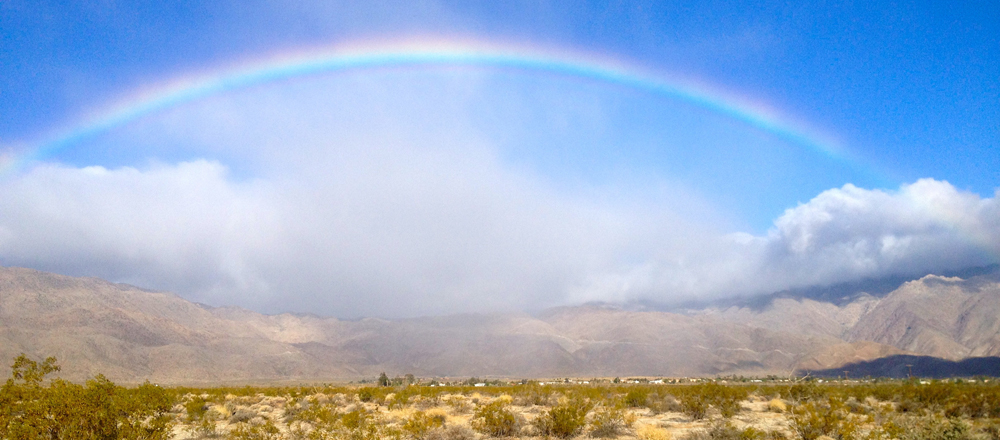
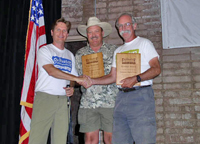
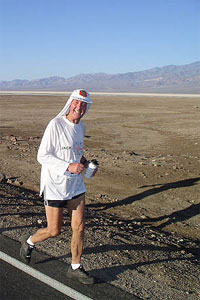 “Death Valley” Jack Denness is something of a legend at the Badwater Ultramarathon. A ten-time finisher before the 2004 race, including a double crossing in the early 1990’s, he entered with high hopes of keeping up with Marshall Ulrich and maintaining his place as joint record finisher at the event.
“Death Valley” Jack Denness is something of a legend at the Badwater Ultramarathon. A ten-time finisher before the 2004 race, including a double crossing in the early 1990’s, he entered with high hopes of keeping up with Marshall Ulrich and maintaining his place as joint record finisher at the event.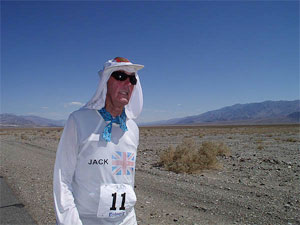 Between Furnace Creek and Panamint Springs, Jack wouldn’t be paced. He had set his heart on finishing almost entirely by himself, although later he would be glad of company. His stride deliberate and determined, he weathered the early morning heat well and reached Furnace Creek in fine fettle.
Between Furnace Creek and Panamint Springs, Jack wouldn’t be paced. He had set his heart on finishing almost entirely by himself, although later he would be glad of company. His stride deliberate and determined, he weathered the early morning heat well and reached Furnace Creek in fine fettle.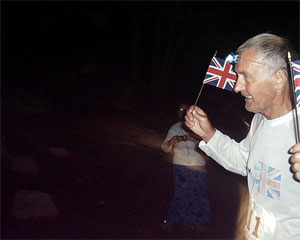
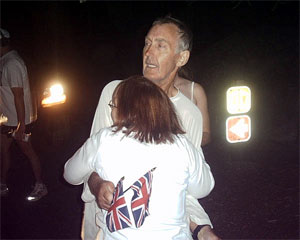
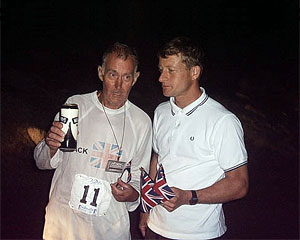
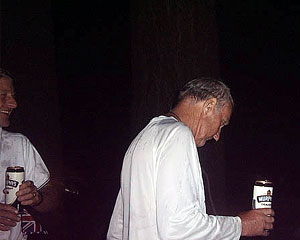
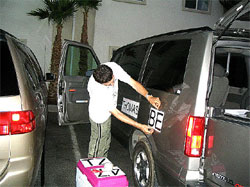 Als das O.K. für die Teilnahme von Thomas (*) am Badwater-Ultramarathon kam, dachte ich, na ja, bei 48 Stunden Köln hab ich Thomas ja schon betreut, diverse 24 Stunden-Läufe und 200 km von Perpignon nach Barcelona, aber die Berichte, die ich über den Badwater-Ultra gelesen hatte, haben mir schon Angst eingeflösst; diese Hitze, davon hielt ich gar nicht viel, hatte mal in Südfrankreich eine Sonnenallergie! Ich sagte mir, mit ein paar Stunden Höhensonne und Allergietabletten im Gepäck wird`s schon gehen. Vor Jahren waren wir schon mal im Death Valley, aber nicht zum BadwaterUltramarathon. Großes Unbehagen vor Badwater hat sich in mein Gehirn gefressen….
Als das O.K. für die Teilnahme von Thomas (*) am Badwater-Ultramarathon kam, dachte ich, na ja, bei 48 Stunden Köln hab ich Thomas ja schon betreut, diverse 24 Stunden-Läufe und 200 km von Perpignon nach Barcelona, aber die Berichte, die ich über den Badwater-Ultra gelesen hatte, haben mir schon Angst eingeflösst; diese Hitze, davon hielt ich gar nicht viel, hatte mal in Südfrankreich eine Sonnenallergie! Ich sagte mir, mit ein paar Stunden Höhensonne und Allergietabletten im Gepäck wird`s schon gehen. Vor Jahren waren wir schon mal im Death Valley, aber nicht zum BadwaterUltramarathon. Großes Unbehagen vor Badwater hat sich in mein Gehirn gefressen….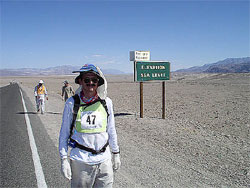 Wir machen Rast in Furneece Creek und machen die Erfahrung, dass man hier Auto-Türgriffe besser nicht mit bloßen Händen anfasst, weil man sich dabei leicht verbrennen kann und eisgekühlte Getränke relativ rasch trinken sollte, weil sie sonst innerhalb kurzer Zeit eine „angenehme „ Temperatur von über 30 Grad haben.
Wir machen Rast in Furneece Creek und machen die Erfahrung, dass man hier Auto-Türgriffe besser nicht mit bloßen Händen anfasst, weil man sich dabei leicht verbrennen kann und eisgekühlte Getränke relativ rasch trinken sollte, weil sie sonst innerhalb kurzer Zeit eine „angenehme „ Temperatur von über 30 Grad haben.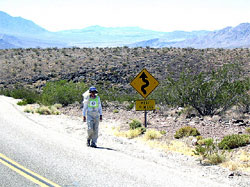 12.7. Wecken um 4 Uhr 30. Start ist um 8 Uhr. Sachen zusammenpacken. Von Beatty geht es nun 67 Meilen nach Badwater. Schnell zum Gruppenfoto aufstellen, noch 10 Minuten bis zum Start. Chris Kostman, der Organisator, wirkt beruhigend auf die Teilnehmer ein, nicht an die ganze Strecke zu denken, sondern in kleinen Schritten. Das klingt logisch, diese Erfahrung habe ich auch schon gemacht, hoffentlich hilft sie auch hier den Teilnehmern. In Gedanken wünsche ich allen Teilnehmern ein gutes Gelingen.
12.7. Wecken um 4 Uhr 30. Start ist um 8 Uhr. Sachen zusammenpacken. Von Beatty geht es nun 67 Meilen nach Badwater. Schnell zum Gruppenfoto aufstellen, noch 10 Minuten bis zum Start. Chris Kostman, der Organisator, wirkt beruhigend auf die Teilnehmer ein, nicht an die ganze Strecke zu denken, sondern in kleinen Schritten. Das klingt logisch, diese Erfahrung habe ich auch schon gemacht, hoffentlich hilft sie auch hier den Teilnehmern. In Gedanken wünsche ich allen Teilnehmern ein gutes Gelingen.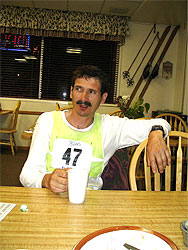 Welche Strecke haben wir insgesamt zu bewältigen? 215 km oder 130 Meilen? Ich entscheide mich für die kleinere Zahl!
Welche Strecke haben wir insgesamt zu bewältigen? 215 km oder 130 Meilen? Ich entscheide mich für die kleinere Zahl!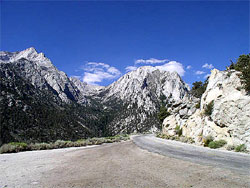 Leider vergisst unser “ soll ich noch einen Kaffee holen – Mann “ mich zu wecken, ist wohl auch eingeschlafen. Ich schwinge mich hinters Steuerrad und fahre los und fahre und fahre und fahre. Nein, ich kann mich nicht verfahren haben, es geht ja immer gerade aus. Endlich, er ist in Sicht. Über 2 Stunden ist er alleine gelaufen. Er ist noch am Leben. Wir sind am Towness Pass und machen halt. Thomas ist sehr müde, legt sich ins Auto. 5 Minuten, noch mal 5 und noch mal 5 will er Pause machen. Verordne ihm eine halbe Stunde ab Stück, nach 1 _ Stunden geht es bergab Richtung Panamint Springs. Unser “ soll ich noch einen Kaffe holen – Mann “ wird ihn begleiten, das wird ihm gut tun. Es ist inzwischen hell geworden. Manchmal kommt der Medical Service vorbei und fragt, ob alles o.k. sei, das beruhigt. Diese Sicht den Berg hinunter ist einfach überwältigend. Außer Thomas`s Müdigkeit geht es uns allen gut.
Leider vergisst unser “ soll ich noch einen Kaffee holen – Mann “ mich zu wecken, ist wohl auch eingeschlafen. Ich schwinge mich hinters Steuerrad und fahre los und fahre und fahre und fahre. Nein, ich kann mich nicht verfahren haben, es geht ja immer gerade aus. Endlich, er ist in Sicht. Über 2 Stunden ist er alleine gelaufen. Er ist noch am Leben. Wir sind am Towness Pass und machen halt. Thomas ist sehr müde, legt sich ins Auto. 5 Minuten, noch mal 5 und noch mal 5 will er Pause machen. Verordne ihm eine halbe Stunde ab Stück, nach 1 _ Stunden geht es bergab Richtung Panamint Springs. Unser “ soll ich noch einen Kaffe holen – Mann “ wird ihn begleiten, das wird ihm gut tun. Es ist inzwischen hell geworden. Manchmal kommt der Medical Service vorbei und fragt, ob alles o.k. sei, das beruhigt. Diese Sicht den Berg hinunter ist einfach überwältigend. Außer Thomas`s Müdigkeit geht es uns allen gut.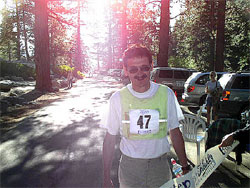 Es wird langsam Nacht. Thomas Müdigkeit kommt immer wieder mal hoch, so wenige Stunden Schlaf in einem Hotel voller “junger Hüpfer“, die die Nacht zum Tag machen, sind vor solch einem Vorhaben wie der Badwaterultra nicht die ideale Vorstellung
Es wird langsam Nacht. Thomas Müdigkeit kommt immer wieder mal hoch, so wenige Stunden Schlaf in einem Hotel voller “junger Hüpfer“, die die Nacht zum Tag machen, sind vor solch einem Vorhaben wie der Badwaterultra nicht die ideale Vorstellung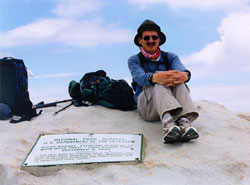 Nach 47 Stunden und 43 Minuten haben wir es geschafft!!! Und auf dem Foto sehen wir gar nicht so müde aus, wie wir uns fühlen. Nur noch ein Gedanke hält mich aufrecht, der Gedanke an ein kühles Motelzimmer mit Bett. Bis zum gemeinsamen Pizzaessen mit Läufern und Begleitern schlafen wir uns aus, oder sagen wir fast.
Nach 47 Stunden und 43 Minuten haben wir es geschafft!!! Und auf dem Foto sehen wir gar nicht so müde aus, wie wir uns fühlen. Nur noch ein Gedanke hält mich aufrecht, der Gedanke an ein kühles Motelzimmer mit Bett. Bis zum gemeinsamen Pizzaessen mit Läufern und Begleitern schlafen wir uns aus, oder sagen wir fast.
